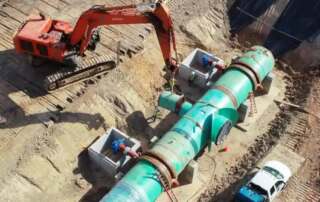by Rachel L. Richardson
Rights-of-way and Eminent Domain
When it comes to the expansion and installation of key pieces of infrastructure—like water, power, sewer systems, roadways, fiber optic lines, and more—planning and process is key. Whether widening roads or extending water lines to accommodate a growing population, state and local governments rely on the principle of eminent domain to establish new infrastructure projects.
Eminent domain allows the government to take private property and convert it to public use, provided the owner is given just compensation—that is, a fair market value as determined by an appraiser (an unbiased, third party). This acquisition or taking would be considered a condemnation of the property so it can be used by the public. When the government and property owner cannot come to an agreement on what just compensation is, it can result in litigation.
At times, the infrastructure does not require a full taking of the property—such as trimming a parcel to accommodate a new or wider roadway—but rather it involves placing legal restrictions on the use of the property while the property ownership remains in place. For instance, a right-of-way (ROW) for an overhead transmission line would be outlined in an easement that prohibits the property owner from constructing buildings within the easement area. This ensures continued access for the personnel that maintain the lines and their service vehicles.
Executive Summary
- When infrastructure is needed in areas that are privately held, the government (through a right referred to as eminent domain) can take private property and convert it to public use, provided the owners are justly compensated.
- Infrastructure may also be accommodated through rights-of-way (typically outlined in an easement) that allow certain types of public use on property still privately owned.
- In this specialty practice area, appraisers analyze what impacts an infrastructure project may have on each property along the planned infrastructure route.
- This analysis involves studying the market, property characteristics, legal precedents, and many other pieces of information in order to determine impact and value.
Based in Houston, Jason Mushinski holds the MAI designation and has been specializing in ROW, condemnation, and litigation for the past 20 years, primarily serving throughout Texas and the Southwest. He is a Senior Managing Director at Valbridge Property Advisors, a member of the International Right of Way Association and he applies his expertise as part of the national Valbridge Property Advisors ROW team—through which he collaborates on projects nationwide.
For Mushinski, a highlight of these appraisals is the opportunity to travel and interact with people involved in all aspects of a project—from design engineers all the way to the property owners the ROW may be impacting. Yes, these projects can pose a challenge. But it’s a rewarding one.
Memorable Projects
Since he’s specialized in these types of valuations for the past 20 years, it may come as no surprise that when asked about memorable projects, Mushinski said: “There’s been numerous.”
“We’ve appraised a one-hundred-eight-inch water line,” he shared. “That’s a nine-foot diameter, high-pressure water line.” This was a time-consuming process, but by the end of it, the project increased the water supply for citizens of the City of Houston and Harris County.
Mushinski also worked with the U.S. Army Corps of Engineers as they acquired avigation easements over a residential area around the Wright Patterson Air Force Base in Ohio. These easements, he described, involve restricting building height and other obstructions in the airport’s flight paths.
“Highway projects in general are rewarding,” he adds. “It’s rewarding meeting with those different types of property owners and their brokers and their managers,” hearing their perspectives on those “different aspects of real estate.”
Know the Value—
For Mushinski, ROW projects signify “progress for the whole infrastructure of our great county.”
For eminent domain to be exercised, though, these infrastructure projects must involve just compensation for the taking of real property: So, what is just, and how do appraisers determine its value?
—Of just compensation
When approaching these appraisals, Mushinski says, “You have to understand that there is some give and take, and there will be some damages or enhancements on a property. But I’m here to look at it not from my own personal opinion but (rather): How do I see a market reacting to those changes in a particular tract, or changes in the marketplace?”
“In any (ROW) project,” he says, “you’re going to have the condemnor and the condemnee.” (The condemnor is whatever party will be acquiring the ROW for the project, while the condemnee is the owner whose real property is along the planned ROW route.) Whether hired by the condemnor or the condemnee, Mushinski shares, as an appraiser he is “representing the property” and therefore “the value will be the same if all data is shared by all parties involved.”
Describing the process, Mushinski tells of a hypothetical project involving a new roadway. “(First) we have to look at property as it sits today without that roadway in place,” he says. “The next step would be to look at the value of that property immediately after that project is in place.” When it comes to determining the negative or positive impacts, if any, of the project on the property, he affirms, “it really has to go back to the market.”
“I can look at the property as it sits today, with the project not in place,” he adds, “But then we must value the property considering the project is in place, not considering construction time. One may think there is a crystal ball to look into the future, but all aspects are based on market influences. For example, the project will construct a six-lane boulevard style roadway. What impacts (albeit negative or positive) will it have on the remainder tract, based on market evidence? It’s often a challenge—but a fun one at that.”
—Amid complexity
Given the regulatory environment and other facets of ROW projects, appraisers in this specialty “have to have a wealth of knowledge,” Mushinski adds.
One element of complexity lies in the fact that by nature most ROW projects are longitudinal—even a comparatively short run of new interstate, for example, can be fifty to a hundred miles and involve “multiple hundreds of parcels” often with different land uses. “Especially within MSAs and the densely developed areas,” he says, “(for the ROW) I’m appraising anything from a car dealership to a retail center, to an industrial development.”
“I have to be competent in numerous property types and markets,” he adds. “At the same time, I must understand the real property type I am appraising.”
Another level of complexity lies in the legal precedents and other specialty knowledge areas specific to these types of valuations. To ensure regulatory compliance, Mushinski and other experts on the ROW team will read through lengthy court cases that have set precedents in this type of real property valuation. Appraisers will also read through other technical documents, such as engineering reports or hydrolysis studies, and interview experts in those fields to understand potential impacts on their subject properties.
“I don’t want to play attorney,” Mushinski says, “but oftentimes I have to think like an attorney. The same goes for a land planner. I’m not a land planner, but oftentimes I have to think like a land planner. The same for an engineer… So, really, you’ve got a toolbox and you’ve got to know what tools to pull out and when.”
Furthermore, ROW appraisers must ensure a consistent application of techniques and market insight at both the higher level of market studies and the more granular level of individual appraisal reports.
Market studies for ROW projects may take a broader view of an area and its trends, resulting in a value range, Mushinski shared. These studies are typically for the condemning authorities, for projects like a new highway corridor that passes through areas with multiple zoning designations or land uses. In this case, Mushinski says, “I’m going to the marketplace, getting a really high-level understanding of those property values and then applying it to this corridor for post-corridor routes based on the segments that we have broken out.” He can then use this market understanding to give the client a value range for each land use, from which they can assess their budgetary needs and know ahead of time if they need to find more funding elsewhere or identify alternative routes.
When it comes to producing appraisal reports for each property along a corridor, however, Mushinski and others on the ROW team must take a more granular look at each parcel or parcels under shared ownership, and ensure they are treated consistently along the line—while also considering the unique factors that impact each property’s value.
“Once we get to the starting point of a project, or right to the property specific, that often becomes challenging for us as appraisers (who are) appraising multiple properties, because you and your neighbor talk,” Mushinski says with a laugh. “There’s a lot of consistencies that must be in the works along a project.”
Perhaps, he shares, one tract is appraised at $10/sf and the next one over is appraised at $5/sf. This type of situation occurs often and is typically due to the parcels having varying characteristics—such as different zoning designations, access to utilities, flood hazards, and so on. “And that’s where my expertise comes in,” Mushinski notes. “And whenever I’m testifying, I have to make sure that we understand all the aspects—all the characteristics of these tracts—and why you were at ten (dollars) here and five on the next one over.”
“It becomes a challenge,” he says, “the more parcels you have with alternative land uses.”
The Value of Synergy
For Mushinski, Valbridge brings the value of collaboration. “I enjoy the Valbridge community in all of our offices,” he says, “(and) the continuity we have across offices… I really enjoy it and think we’ve only seen the tip of the iceberg for things to come here at Valbridge.”
Specialty experts on the Valbridge ROW team, like Mushinski, collaborate with designated appraisers in Valbridge offices across the nation. This combination of local insight with specialty expertise delivers informed and data-driven valuations—including for complex projects that cross state lines.
“This organization allows us to come together with the same goal in mind,” Mushinski adds. “It allows us to have that synergy in what we do and what we offer our clients nationwide.”




